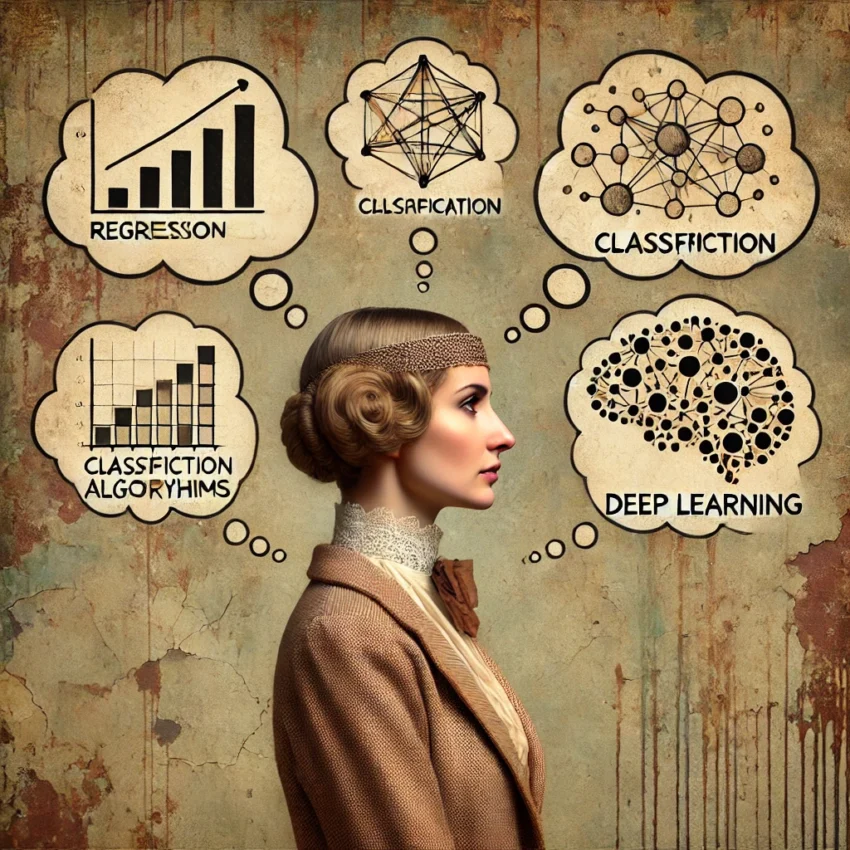Machine Learning
Machine Learning is a branch of Artificial Intelligence that focuses on developing models capable of making predictions and decisions by analyzing complex data and identifying patterns and correlations within it.
The origins of Machine Learning can be traced back to the 1950s. Alan Turing’s studies laid the groundwork, followed by Arthur Samuel who, in 1959, coined the term and created algorithms that exhibited intelligent characteristics—improving their performance through experience.

Despite these early advancements, the discipline didn’t gain significant traction until the 2000s. This delay was due to limited computational capabilities and a scarcity of data. However, after 2000, the field began to develop rapidly, thanks to the emergence of powerful computers and the massive collection of “big data.”
Definitions: Artificial Intelligence (AI), Machine Learning (ML), and Deep Learning (DL)
Artificial Intelligence (AI) is the discipline focused on developing systems capable of performing tasks that require “intelligence.” These tasks include solving problems, making decisions, understanding language, recognizing images, and interacting with the surrounding environment.
Currently, we use “weak” or “narrow” AI, which specializes in particular sectors. In contrast, “strong” AI—capable of working across different sectors and exhibiting human-like learning behavior—remains theoretical.
Machine Learning (ML), a field within AI, analyzes data and improves its performance in specific tasks based on this “experience.” ML encompasses several subcategories:
Supervised learning: The model trains on data with known solutions
Unsupervised learning: The model works with data lacking predefined solutions
Reinforcement learning: The system learns through trial and error, guided by rewards and penalties
Deep Learning, a subset of ML, employs neural networks to analyze data. These mathematical systems mimic the human brain’s behavior by creating layers of “neurons” that process information. Thanks to its capacity to handle vast amounts of data, Deep Learning can perform complex tasks such as image recognition and natural language processing (both comprehension and production).
Machine Learning Techniques
Different Machine Learning techniques can be employed based on the problem at hand and the nature of the data. Here’s a summary of the most important techniques, which we’ll explore in greater detail in the following sections:
Regression
Regression algorithms are a fundamental class of machine learning techniques used for predicting continuous numerical values. These algorithms establish relationships between input variables (features) and a target variable, allowing for precise estimations. Linear regression, one of the most widely used regression methods, models the linear relationship between variables. Other types include polynomial regression for non-linear relationships and multiple regression for scenarios with multiple input variables. Regression is particularly useful in forecasting trends, such as predicting house prices based on various features or estimating future sales figures.
Classification
Classification algorithms are designed to categorize data points into predefined classes or labels. These powerful tools analyze input features to determine the most likely category for each instance. Popular classification methods include K-nearest neighbors (KNN), which classifies based on the majority class of nearby data points, and support vector machines (SVM), which find optimal boundaries between classes. Other notable algorithms include decision trees, random forests, and logistic regression. Classification has diverse applications, from spam detection in emails to medical diagnosis based on patient symptoms and test results.
Clustering
Clustering algorithms are unsupervised learning techniques that identify inherent groupings within data without predefined labels. These methods analyze similarities and differences between data points to form clusters of related items. The K-means algorithm, widely used for its simplicity and efficiency, partitions data into K clusters based on feature similarity. Other clustering approaches include hierarchical clustering, which creates a tree-like structure of clusters, and DBSCAN, which forms clusters based on density. Clustering is valuable for market segmentation, anomaly detection, and pattern recognition in complex datasets.
Dimensionality Reduction
Dimensionality reduction techniques are crucial for managing high-dimensional datasets while preserving essential information. These methods transform data into a lower-dimensional space, facilitating easier analysis and visualization. Principal Component Analysis (PCA), the most renowned algorithm in this category, identifies the principal components that capture the most variance in the data. Other techniques include t-SNE for non-linear dimensionality reduction and autoencoders in deep learning. These methods are invaluable for feature selection, noise reduction, and improving the efficiency of machine learning models when dealing with complex, high-dimensional data.
Deep Learning
Deep Learning represents a sophisticated subset of machine learning that employs artificial neural networks inspired by the human brain’s structure and function. These models consist of multiple layers of interconnected nodes or “neurons” that process and transform input data. The simplest form, the Artificial Neural Network (ANN), is a foundation for more complex architectures. Convolutional Neural Networks (CNNs) excel in image and pattern recognition tasks, utilizing specialized layers to detect features hierarchically. Recurrent Neural Networks (RNNs) are designed for sequential data, making them ideal for natural language processing and time series analysis. Advanced variants like Long Short-Term Memory (LSTM) networks and Transformers have revolutionized machine translation and sentiment analysis tasks. Deep Learning’s capacity to automatically learn hierarchical representations from raw data has led to breakthroughs in computer vision, speech recognition, and numerous other domains.
Machine Learning Tools
Python is the most widely used programming language for Machine Learning, thanks to its ease of use and the availability of powerful dedicated libraries.
Notable examples include:
Scikit-learn: A library offering both ML algorithms and data processing tools
TensorFlow and Keras: Google-developed libraries for building neural networks
PyTorch: A Facebook-developed library popular in research and practical applications due to its execution speed
For model development and testing, interactive tools like Jupyter Notebook and Google Colab are invaluable.
Conclusion
Machine Learning represents one of the most transformative technological advancements of the 21st century. From its theoretical foundations in the 1950s to today’s sophisticated applications, ML has evolved from an academic curiosity into a tool driving innovation across industries. Understanding the fundamental concepts presented in this introduction provides a solid groundwork for deeper exploration into this fascinating field.lying assumptions.


